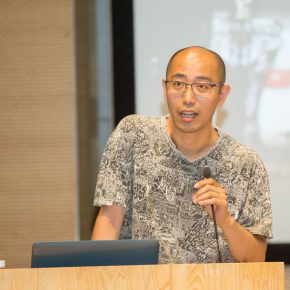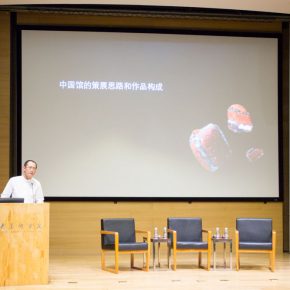
On the evening of June 10, on the occasion that it was the World Cultural and Natural Heritage Day, Prof. Qiu Zhijie, Dean of the School of Experimental Art, CAFA, an artist and the curator of the China Pavilion at the Venice Biennale 2017, gave a lecture in the Auditorium of CAFA Art Museum, to tell the triumph of intangible cultural heritage in China to the audience from all walks of life, who are focused on the China Pavilion of Venice Biennale, he explained in detail the curatorial concept of the China Pavilion, ideas on arranging the exhibition and responded to the praise and criticism from all walks of life.
At the beginning of the lecture, Wu Jian’an, a teacher from the School of Experimental Art, CAFA, and a participating artist of the China Pavilion hosted the lecture. Then the speaker Qiu Zhijie explained the Chinese exhibition of the Venice Biennale in detail, first of all, Prof. Qiu Zhijie systematically divided the lecture into three parts: initially, focusing on curatorial ideas and the arrangement of works of the China Pavilion. Secondly, discussing the issue of intangible cultural heritage. Thirdly, responding to the public evaluation of China Pavilion and the problems. He said: “The trip to the Venice Biennale has received feedback which is unprecedented polarized.”
The theme of “Continuum” and Curatorial Ideas
First of all, the exhibition of the China Pavilion at the Venice Biennale is themed the “Continuum”, which is diverted from Chinese traditional culture. “Zhouyi – Xiangzhuan” said: “While the universe keeps rolling on an orbit, a superior man makes untiring endeavors for advancement. “Continuum” is a positive and strong image, with an extremely far-reaching impact on the Chinese culture. The chief theme of the Venice Biennale is “Viva Arte Viva”, meaning long live the art. Qiu Zhijie said that, “The chief curator of the exhibition Christine Macel stated that the chief theme “Viva Arte Viva” involves two aspects: firstly, the show is designed by artists for artists. My main identity is an artist, so I am in line with this demand. Secondly, it hopes that through the exhibition to explore the undiscovered or forgotten artists, with a vision covering all corners of Africa, Latin America and Asia. So I proposed 'Continuum' as the theme of China Pavilion.”
The concept of “Continuum” is proposed which is associated with Xu Beihong’s painting of “The Foolish Old Man, who removed the mountains with his family”. Chinese mythology is full of prototypes about a variety of “changes”, such as “The Foolish Old Man, who removed the mountains with his family” and “The Mythical Bird Jingwei who tried to fill up the sea with pebbles”, etc. “Zhouyi” started a thinking model to make Chinese culture form a continuous continuum, the theory of existence in China is built on the basis of “change”, compared with the theory of existence in Western philosophy that is built on the basis of a solid entity. In other words, “Continuum” is a collective choice, and the subconscious is constantly associated with the present generation along with the ancient people and future society.
On the “Intangible Cultural Heritage” Participating in the Venice Biennale
When the curatorial team and the artists started constructing an exhibition idea and works of art, the first thought of the two paintings which are considered as a citation of the exhibition, Li Song’s “Skeleton Fantasy Show” and Ma Yuan’s “Twelve Images of Water Surging”, which are both related to the unique view of time, life and death and all kinds of thinking for Chinese people. Our “Continuum” is also built on the basis of a continuous interaction between the elite and the masses. In the thousands of years of Chinese art history, folk art plays a role of never-ending source and amaternal role. From the Dunhuang craftsmen to the female embroiderers from Suzhou, the creators of Chinese art was not only the pedant of the studios, but also when Chinese culture was faced with exhaustion each time, we could always return to folk to find our own cultural and artistic roots. For the above reasons, I decided the list of artists for the China Pavilion – Tang Nannan, Wang Tianwen, Wu Jian’an and Yao Huifen. Shadow puppet master Wang Tianwen from the rough and simple Northwest of China, Suzhou embroidery master Yao Huifen from the graceful and exquisite Jiangnan Water Village, Tang Nannan and Wu Jian’an from the academies, Wu Jian’an absorbs nourishment from Chinese paper-cut and traditional mythology, Tang Nannan developsphotography and video artwith ink and wash, and the key word is “cooperation”, each artist is in collaboration with the other three artists for the exhibition of the China Pavilion, to form an inter-textual collective creation network. The exchange of a large amount of information is of a strong feature in the internet era.
From the perspective of the overall idea of the China Pavilion, art is not an individual creation for the artist who has a life and death, but a collective creation that has lasted for thousands of years. Therefore, the exhibition team further turned the aura and image of “continuum” towards documentary proof. On the documentary wall, it displays the teachers of each participating artist. The documentary zone has a pivotal position in the structure of the China Pavilion, and the map of inheritance describes the exhibition as a temporary node in a mobile network. It is a map of inter-cooperative relationships of the artists in the documentary zone. The map of “Continuum” which was drawn by Qiu Zhijie portraits China, art and even the show to form a lump of continuum fire. The documentary zone also presents the efforts of Chinese artists returning to folk of the past century.
After introducing an overview of the works, Qiu Zhijie began to show the audience the ideas for arranging the exhibition and the general process of the China Pavilion. “Gatherings, temple fairs, theater” are three key words to arrange the show. Throughout the exhibition hall, the details and visual effects of the exhibition hall are fabulous, and the application of the space aims at creating the stratified dialogues and communications between the new and old, the elegance and vulgar, China and other countries, inside and outside, to form a large-scale “gathering-like” energy field. In the outdoor part, Tang Nannan’s “Global Beach Archaeological Project” was made in a tent, Tang took photos of drifters from beaches around the world and brought them together to create a huge beach, following on from this he asked some people to analyze the drifters using archeology. Prof. Qiu Zhijie introduced three acts on-site that happen in the China Pavilion synchronously for the audience: act 1 is the shadow puppet of “The Foolish Old Man, who removed the mountains with his family”, act 2 is the show of “The Mythical Bird Jingwei who tried to fill up the sea with pebbles”, played by volunteers composed of students of the academy and Chinese students studying abroad in Italy, act 3 is the “Change between the Fish Kun and the Bird Peng”performed by amechanical arm. The whole performance is applied onsite with switching, composed of video and performing, the interaction between the video and shadow puppet in the screen is an important breakthrough for this exhibition.
Responding to Doubts: “Venice Biennale is full of Intangible Cultural Heritage from Many Countries”
Qiu Zhijie then made an interesting response to the doubts about the trip of the Venice Biennial – he said that in the previous biennials, various halls were closely associated with the country’s own “intangible cultural heritage”. German Pavilion presents “Faust” which is a genuine German “intangible cultural heritage”. The essential work of the Italian Pavilion is also extended from Western theology. The embroidery and shadow play exhibited by the China Pavilion have experienced contemporary reform, when the shadow play started in the exhibition hall, the shadow play that is perishing encountered an important and new moment in the 2000 years of history. Qiu Zhijie said: “Whether an exhibition is good or bad, the answer is through the audience in Venice who vote with their feet. When the opening ceremony of the biennial was about to start, the organizers came to ask us to suspend the shadow puppetry in the Chinese Pavilion, or a large number of spectators would stay in the China Pavilion and miss the opening ceremony.”
Entering the final section, Qiu Zhijie invited the exhibitor Wu Jian’an and Chen Zhiyuan, the representative of the curatorial team, to talk about his thoughts of this trip to Venice from the artist’s perspective of creation and the perspective of curating.
Prof. Qiu Zhijie said: “The Venice Biennale is different from the Olympic Games and the Expo that aim at showing the national power and shaping of tourist destinations. It is a way of art, to propose problems, embarrassment and difficulties encountered by each country, as well as the solutions of these problems by the artists who face these problems, to achieve reconciliation in the process of exchange of information. How do we retain our original set of “continuum” mechanisms in art production in the process of rapid economic development?” Prof. Qiu Zhijie then quoted Liang Qichao’s words reading that: “In order to finish a big deal, one has to first ignore the idea of success and failure, but it is a tough for people. One must understand that there is neither success nor failure in the world.” It is as a summary of the curatorial experience of the China Pavilion.
At the end of the lecture, President of CAFA Fan Di’an went to the stage and gave a conclusion to the lecture. He pointed out that Prof. Qiu did not only talk about curatorial ideas and ways of the China Pavilion in the Venice Biennale, but was also involved in the issue of “how do we think of the contemporary direction of Chinese art in a global context, how do we think of the gestures and methods for Chinese art in dialogue with the world,” which is worthy of our thoughts.
Text by Du Mengqian and edited by Lin Jiabin/CAFA ART INFO
Translated by Chen Peihua and edited by Sue/CAFA ART INFO
Photo and video by Hu Sichen/CAFA ART INFO







































